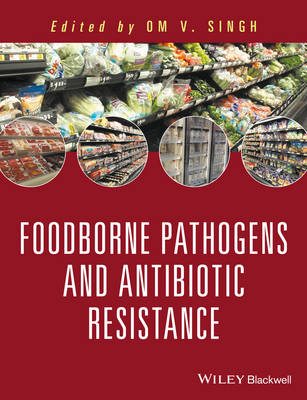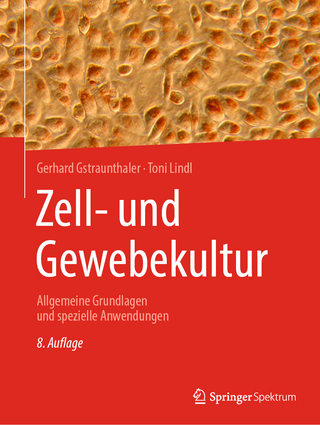
Food Borne Pathogens and Antibiotic Resistance
John Wiley & Sons Inc (Verlag)
978-1-119-13915-7 (ISBN)
Foodborne Pathogens and Antibiotic Resistance addresses this timely topic in five sections. Chapters will first introduce food pathogens and explore their ability to spoil different food materials, including genetically modified foods. From there, the text will delve into an overview of methodologies used to screen for and identify different food pathogens. The third section will review literature on various food pathogens and molecular mechanisms of food spoilage. The fourth section will focus on the evolution of antibiotic resistance in various foodborne pathogens. The text then closes with a section on regulations put in place by various regulatory agencies, such as the FDA and USDA.
Dr. Om Singh, Associate Professor of Biology, Division of Biological and Health Sciences, University of Pittsburgh Bradford. Before coming to Pitt-Bradford, Om was a visiting assistant professor and visiting scientist at The Johns Hopkins School of Medicine, where he also served as a postdoctoral research associatefor five years. He is currently editor-in-chief for the "Journal of Radioprotection Research" and "Biological Research and Reviews." In 2013, he edited a book, "Microbial Bio-Nanotechnology: Resources of Green Biotechnology," which will be published in December 2014. He is a member of numerous editorial boards and professional organizations.
List of Contributors
Preface
Introduction
Chapter 1: Diversity of foodborne bacterial pathogens and parasites in produce and animal products and limitations of current detection practices
Debabrata Biswas and Shirley A. Micallef
1.1. Introduction
1.2. Common bacterial pathogens and parasites found in produce and animal products
1.3. Unusual bacterial pathogens and parasites in produce and animal products
1.4. Farming systems and mixed (integrated) crop-livestock farming
1.5. Major sources of unusual/under-researched bacterial pathogens and parasites in food
1.6. Diversity of farming and processing practices and possible risks
1.7. Current hygienic practices and their effects on these under-researched pathogens
1.8. Current detection methods and their limitations
1.9. Recommendation to improve the detection level
1.10. Conclusion
References
Chapter 2: Characterization of foodborne pathogens and spoilage bacteria in Mediterranean fish species and seafood products
A. Bolivar, J. Correira, G. D. Posada-Izquierdo, F. Pérez-Rodríguez, I. Bascón and A. Valero
2.1. Fish quality assurance
2.2. Microbiological Standards to be accomplished
2.3. Hazard Analysis and Critical Control Points (HACCP) implemented in the fishery industry
2.4. Microbial ecology of Mediterranean fishery products
2.5 Fish and seafood spoilage: Characterization of spoilage microorganisms during capture, manufacture and distribution of fishery products
2.6. Foodborne pathogens in Mediterranean fishery products
2.7. Molecular methods for pathogen detection in fishery products
References
Chapter 3: Food spoilage by Pseudomonas spp. – An overview
António Raposo, Esteban Pérez, Catarina Faria, María Antonia Ferrús and Conrado Carrascosa
3.1. Introduction
3.2. Pseudomonas spp. in milk and dairy products
3.3. Meat spoilage by Pseudomonas spp.
3.4. Fish spoilage by Pseudomonas spp.
3.5. Water contamination by Pseudomonas spp.
3.6. Pseudomonas spp. in fruit and vegetables
3.7. Biochemical and Molecular techniques for Pseudomonas spp. detection
3.8. Conclusions
References
Chapter 4: Arcobacter spp. in food chain – From culture to omics
Susana Ferreira, Mónica Oleastro and Fernanda Domingues
4.1. Introduction
4.2. Isolation and detection of Arcobacter
References
Chapter 5: Microbial hazards and their implications in the production of table olives
A. Valero-Díaz, E. Medina and F.N. Arroyo-López
5.1. Table olives: Origin, production and main types of elaborations
5.2. Importance of microorganisms in table olives
5.3. Molecular methods for the study of microbial populations in table olives
5.4. Biological hazards in table olives
5.5. Use of starter cultures to reduce biological hazards in table olives
5.6. Hazard Analysis and Critical Control Point (HACCP) system as a useful tool to improve microbial safety and quality of table olives
5.7. Conclusions
References
Chapter 6: The Problem of spore-forming bacteria in food preservation and tentative solutions
Stève Olugu Voundi, Maximilienne Nyegue, Blaise Pascal Bougnom, François-Xavier Etoa
6.1. Introduction
6.2. Sporulation
6.3. Metabolic state of the spore
6.4. Spore structure and associated mechanisms of resistance
6.5. Germination of spore
6.6. Problems of spore-forming bacteria in food preservation
6.7. Techniques of spore inactivation
References
Chapter 7: Insights into Detection and Identification of Foodborne Pathogens
Jodi Woan-Fei Law, Vengadesh Letchumanan, Kok-Gan Chan, Bey-Hing Goh, Learn-Han Lee
7.1. Introduction
7.2. Nucleic Acid-Based Methods
7.3. Conclusion
References
Chapter 8: Rapid, alternative methods for Salmonella detection in food
Anna Zadernowska and Wioleta Chajęcka-Wierzchowska
8.1. Introduction
8.2. Conventional methods and their modifications
8.3. Alternative methods - definitions, requirements
8.4. Conclusions
References
Chapter 9: CRISPR-mediated Bacterial Genome Editing in Food Safety and Industry
Michael Carroll and Xiaohui Zhou
9.1. Introduction
9.2. Application of CRISPR for Bacterial Genome Editing
9.3. Vaccination of Industrial Microbes
9.4. Application of CRISPR in the Development of Antimicrobials
9.5. CRISPR Delivery Systems
9.6. Concluding Remarks
References
Chapter 10: Meatborne Pathogens and Use of Natural Antimicrobials for Food Safety
Ashim Kumar Biswas and Prabhat Kumar Mandal
10.1. Introduction
10.2. Incidences of Some Important Food-Borne Pathogens
10.3. Application of Natural Antimicrobials
10.4. Regulatory Aspects of Natural Antimicrobials
10.5. Health Benefits of Natural Antimicrobials
10.6. Summary
References
Chapter 11: Foodborne Pathogens and Their Apparent Linkage with Antibiotic Resistance
Mariah L. Cole and Om V. Singh
11.1. Introduction
11.2. Food Spoilage
11.3. Food Processing and Microbial Contamination
11.4. Foodborne Pathogens and Antibiotic Resistance
11.5. Antibiotics and Alternatives
11.6. Genomics and Proteomics of Food-Borne Pathogens and Antibiotic Resistance
11.7. Conclusion
References
Chapter 12: Antimicrobial food additives and disinfectants: mode of action and microbial resistance mechanisms
Meera Surendran Nair, Indu Upadhyaya, Mary Anne Roshni Amalaradjou and Kumar Venkitanarayanan
12.1. Introduction
12.2. Food additives
12.3. Mode of action and resistance to antimicrobial food preservatives
12.4. Disinfectants
12.5. Mode of action and resistance to disinfectants
12.6. Plant derived antimicrobials as alternatives
12.7. Conclusion
References
Chapter 13: Molecular Biology of Multidrug Resistance Efflux Pumps of the Major Facilitator Superfamily from Bacterial Food Pathogens
K C Ranjana, Ugina Shrestha, Sanath Kumar, Indrika Ranaweera, Prathusha Kakarla, Mun Mun Mukherjee, Sharla A. Barr, Alberto J. Hernandez, T. Mark Willmon, Bailey C. Benham, and Manuel F. Varela
13.1. Foodborne bacterial pathogens
13.2. Major classes of clinically important antibacterial agents
13.3. Antimicrobial agents used in food animals for treatment of infections
13.4. Antimicrobial agents used in food animals for prophylaxis
13.5. Antimicrobial agents used in food animals for growth enhancement
13.6. Mechanisms of Bacterial Resistance to Antimicrobial Agents
13.7. The major facilitator superfamily of solute transporters
13.8. Key bacterial multidrug efflux pump systems of the major facilitator superfamily
13.9. Future directions
References
Chapter 14: Prevalence, evolution, and dissemination of antibiotic-resistance in Salmonella
Brian W. Brunelle, Bradley L. Bearson, and Heather K. Allen
14.1. Introduction
14.2. Antibiotic resistance prevalence among Salmonella serotypes
14.3. Antibiotic treatment of Salmonella
14.4. Antibiotics and resistance mechanisms
14.5. Evolution and transfer of antibiotic resistance
14.6. Co-localization of resistance genes
14.7. Conclusions
References
Chapter 15: Antibiotic resistance of coagulase-positive and coagulase-negative staphylococci isolated from food
Wioleta Chajęcka-Wierzchowska, Anna Zadernowska
15.1. Characteristics of the genus Staphylococcus
15.2. Coagulase-positive staphylococci
15.3. Coagulase-negative staphylococci
15.4. Genetic mechanisms conditioning antibiotic resistance of staphylococci
15.5. Food as a source of antibiotic-resistant staphylococci
15.6. Summary
References
Chapter 16: Antibiotic resistance in Enterococcus spp. Friend or foe?
Economou Vangelis, Sakkas Hercules, Delis Georgios and Gousia Panagiota
16.1. Introduction
16.2. Enterococcus biology
16.3. Enterococcus as a probiotic
16.4. Enterococcus in food
16.5. Antibiotic resistance
16.6. Enterococcus infection
16.7. Enterococcus epidemiology
References
Chapter 17: Antibiotic resistance in seafood-borne pathogens
Sanath Kumar, Manjusha Lekshmi, Ammini Parvathi, Binaya Bhusan Nayak and Manuel F. Varela
17.1. Human pathogenic bacteria in seafood
17.2. An overview of bacterial antimicrobial resistance mechanisms
17.3. Antibiotic resistant bacteria in the aquatic environment
17.4. Antimicrobial resistance in seafood-borne pathogens
17.5. Antimicrobials in aquaculture and their human health consequences
17.6. Future directions
References
Chapter 18: Antimicrobial resistance of Campylobacter sp
Tareq M. Osaili and Akram R. Alaboudi
18.1. Introduction
18.2. Antimicrobial resistance
18.3. Consequences of foodborne antimicrobial resistance on human
18.4. Antimicrobial resistance mechanisms
18.5. Antimicrobial susceptibility testing of Campylobacter
18.6. Campylobacter antimicrobials resistance: global overview
18.7. Antimicrobial resistance of Campylobacter isolated form the Middle East region
18.8. Strategies to prevent future emergences of bacterial resistance
References
Chapter 19: Prevalence and Antibiogram of pathogenic foodborne Escherichia coli and Salmonella spp in developing African countries
Adeyanju, Gladys Taiwo
19.1. Introduction
19.2. Factors That Play A Role In The Epidemiology Of Foodborne Diseases
19.3. Food poisoning and food vending
19.4. Foodborne Colibacillosis and Salmonellosis
19.5. Antibiotic resistance
19.6. Reasons For Resistance Against Specific Antibiotics
19.7. Antibiotic resistance of Salmonella
19.8. Antibiotic resistance of Escherichia coli
19.9. How To Combat Foodborne Diseases And Antibiotic Resistance
References
Chapter 20: Evolution and prevalence of multidrug resistance among food borne pathogens
Sinosh Skariyachan, Anagha S Setlur and Sujay Y Naik
20.1. Introduction
20.2. Major Causes of the evolution of Bacterial drug resistances
20.3. Food Poisoning and Food borne illness-An overview
20.4. Factors that influence the growth of food borne pathogens in food products
20.5. Food poisoning and Food borne infections
20.6. An illustration of major food borne Gastroenteritis
20.7. Major types of antibiotics used to treat food borne infections
20.8. Mechanisms of evolution of antibiotic resistance in food products
20.9. Evolution of XDR and PDR bacteria
20.10. Need for caution and WHO/ FDA stands towards the development of MDR pathogens in foods
20.11. Possible solutions and Recommendations for prevention
20.12. Conclusion
References
| Erscheinungsdatum | 15.01.2017 |
|---|---|
| Verlagsort | New York |
| Sprache | englisch |
| Gewicht | 666 g |
| Einbandart | gebunden |
| Themenwelt | Naturwissenschaften ► Biologie ► Mikrobiologie / Immunologie |
| Technik ► Lebensmitteltechnologie | |
| Technik ► Umwelttechnik / Biotechnologie | |
| ISBN-10 | 1-119-13915-5 / 1119139155 |
| ISBN-13 | 978-1-119-13915-7 / 9781119139157 |
| Zustand | Neuware |
| Haben Sie eine Frage zum Produkt? |
aus dem Bereich


